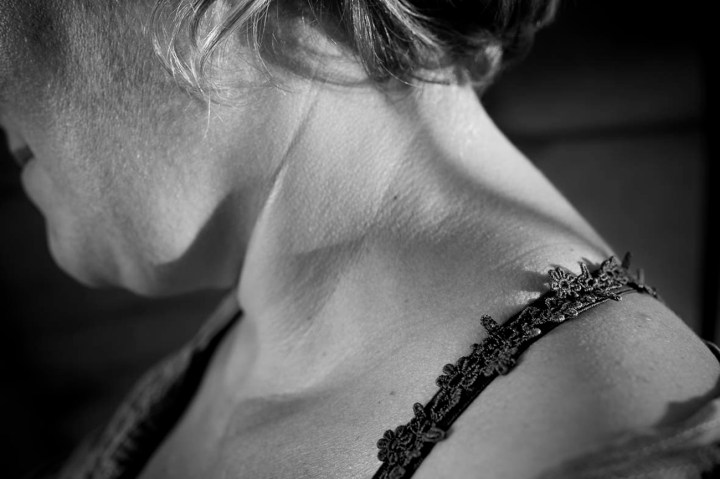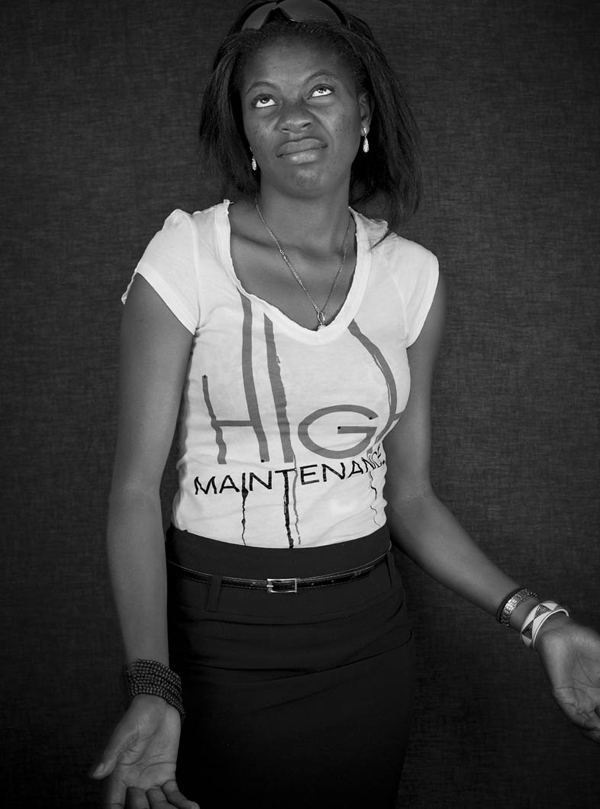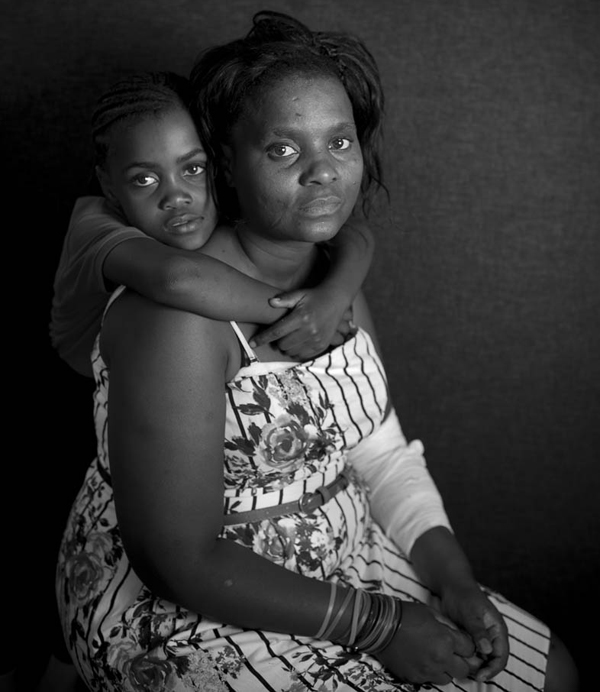Maverick Life, Media, South Africa
‘Not Me – Not Mine’. The nexus between women & HIV

Media headlines give the numbers and news of the HIV/Aids epidemic, but the human narrative is increasingly getting lost in faceless media coverage. Photographer Leonie Marinovich’s exhibition at the Standard Bank Gallery challenges that narrative. By MANDY DE WAAL.
When it comes to HIV/Aids, the news is mostly anonymous, an abstraction that creates a faceless pandemic, which makes it so much easier to turn the page. Click your mouse and you’re on to the next story.
Then there’s the unblinking gaze of Leonie Marinovich’s exhibition Not Me – Not Mine, which is an intimate narrative of urban women living with HIV.
“I feel strongly that people need to tell their own story. I tried that with the photography as well. I tried not to editorialise with the photography and the picture- taking itself,” she says.
[Disclosure: Leonie’s husband, Greg Marinovich is an associate editor of iMaverick/Daily Maverick – Ed]
The result is a close-up view of what it means to be a woman and to be HIV-positive in Africa. People like 25-year-old Helena Nangombe offer the raw and real truth: “I contracted HIV when I was raped. I was raped by a very close family member, my cousin. In the house where I lived. It was quite confusing, as I was just a little girl.”

Photo: Helena Nangombe.
“I didn’t want to be lonely at school. So most of the time I was just there, trying to have fun and forgetting the fact that I have Aids. I’m self-confident, ambitious, beautiful, I’m a dreamer. I dream big.” And “of course, I’m looking for another relationship. Why not? I like being loved.”
These personal revelations come, in part, from Marinovich’s intent to enable the women to tell their own story.
“I basically put a backdrop,” says Marinovich. “I let the women dress the way they wanted to. I let them pose the way they wanted to. I basically chatted with them to make them feel comfortable, and tried to take pictures at the same time. I basically wanted to present them in the way that they wanted other people to see them.”
Marinovich says there are so many rumours, stories and stigmas around HIV/Aids that she didn’t want the narrative of the women sharing their lives and experiences to be reinterpreted. The news headlines and the statistics rob HIV of its human face and dehumanise what is a very human epidemic, Marinovich believes.
One of the questions Marinovich continually asked the women she was interviewing for the exhibition was whether they felt HIV had defined who they were. The answers were always different.
“First of all, I found out he had cheated and I asked him about condom use and he kind of said yes and I half believed him,” Linda de Villiers told Marinovich. “The thing is you never know what you’ll feel, right? And the period from when I got tested to when I got the results were the worst of my life, because I didn’t know for sure. I sent a lot of really rude SMSes to my ex at the time, while I was waiting for the test.”
“My doctor said ‘you’re HIV-positive’. For some reason, I felt some relief, okay, at least I know. Now I know what it is, I know what to do and how to deal with it and I’ll deal with it. I wasn’t angry anymore, I lost my anger. I can’t go backwards, I don’t want to go down, there’s only one way to go and that’s forwards, really.”
Marinovich says her key purpose with this exhibition – which opens at the Standard Bank Gallery on 2 May and will then tour – is that she wants people to relate to others as people, not labels.
“It is so easy to label people. That is what we feel comfortable with. Either you are white, or you are black, or you are an Afrikaner, or you are a Jew. You are HIV-positive. You are an Aids orphan. Through that label you lose your identity in other people’s eyes,” says Marinovich.
“What I found so powerful about this is that afterwards I forgot that the people I was speaking to were HIV-positive and the interview went to places like: ‘How do you actually date at your age?’ and ‘How are you going to cope with menopause?’
“What I found striking is how people deal with body image. Having to deal with HIV and taking ARVs complicates matters. You get all sorts of weird physical side effects,” says the documentary filmmaker and photographer who has exhibited at the Bell-Roberts Gallery in Cape Town, Museum Africa in Johannesburg and at the World Intellectual Property Organisation in Geneva.
“It is the kind of thing that Anne Leon called a ‘camel’s hump’. That’s when a fatty deposit realigns itself on your body, so suddenly you have a fat deposit on your shoulders. Or you lose you bum. Tender Mavundla talks about that: for a Zulu girl to lose her bum is quite something. Suddenly she’s being told that she looks like a Xhosa,” Marinovich says.

Photo: Anne Leon.
“I think that’s part of the reason why white people are not so open about speaking about their status. Black people live in close communities with each other and from the interviews I have picked up that a lot revolves around how you look. I think that people are sometimes semi-oblivious to what other people look like, and you can get away with it if you are white. But if you are black and you lose your bum or your skin goes darker you have to offer up an explanation. It makes living with HIV more complicated,” she says.
Marinovich has photographed women with HIV in rural areas with her husband, Pulitzer prize-winning photographer Greg Marinovich, over a number of years. She says many of the myths evident in rural areas seem to grow legs and walk into urban settings.
“If you are disabled you are either not supposed to have sex or you are a sex maniac if you are having sex. One of the women I interviewed is HIV-positive and is disabled. She has a double stigma.”
The difference between urban and rural women living with HIV, Marinovich says, is that urban women articulate their feelings more openly and are more willing to talk about traditional beliefs and sexual practices.
“In the rural areas these things are not accepted as part of the norm and people weren’t that open to talking about them,” says Marinovich.
“Oh gosh, and the rumours that come out. But that’s a whole different story about sexual practices in some of the communities. In some of the Namibian villages it was common practice to swing. The whole village sleeps with each other’s partners,” she says.
“With the Herero people, I was told that if an uncle comes to visit the household and the father is not there the uncle has a right to any girl that has already started menstruating. This is something that people do not talk about at all, not even in official circles. And if you don’t understand the language and some of the coding you will miss it completely,” says Marinovich.
“What upset me is that one of the women I interviewed was raped by a relative when she was younger, about eight. When she told her family about it they took her to a sangoma who then said she had a spiritual husband. It struck me that to come up with the phrase ‘spiritual husband’ must be a common occurrence. It was a matter of her dreaming about it – it was interpreted as her having got a ‘spiritual husband’ and so it never happened.”
Marinovich would often spend days with the women that she was photographing and interviewing in South Africa and Namibia, and found that as she spent more time with the women, intimate details of their life would emerge.
“Scholastica Goagoses is an ex-sex worker and I have a lot of admiration for her because she managed to get herself off drug and alcohol dependence by going cold turkey. By late on the second day she actually confessed that she had abused her children, in part because of the way she was brought up and because of all her anger towards men and her family who rejected her. If those were her role models, it was incredible that she could eventually rise above all that,” Marinovich says.

Photo: Scholastica Goagoses.
“If you don’t spend enough time with people it will never come out. I hope that I provided an open forum for people to get comfortable with me and to share these things with me, and that they won’t live to regret it.”
Marinovich’s hope is that the exhibition will enable people to relate to women with HIV one-to-one, as individuals. “Once we have personalised something, once we’ve given it a face, it becomes so much more difficult to stigmatise it or to reject it,” she says. DM
Not Me – Not Mine. An exhibition of photographs by Leonie Marinovich at the Standard Bank Gallery, Corner Simmonds and Frederick streets, Johannesburg. Exhibition opens on 2 May and runs to 9 June 2012.
Read more:
- Govt wants Aids tests for 35,000 students.
- SA has lost 4.4m people to Aids.
- Preventing Aids: A drug called money.
- Write up of Not Me – Not Mine at The Standard Bank Gallery.
Photo: Linda de Villiers. All photos by Leonie Marinovich.


















 Become an Insider
Become an Insider